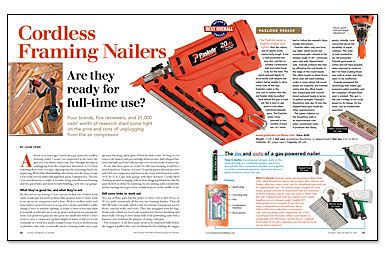Cordless Framing Nailers
Four brands, five reviewers, and 25,000 nails shed some light on the pros and cons of unplugging from the air compressor.

Synopsis: When builder John Spier faced the prospect of assessing today’s crop of cordless framing nailers, he was eager to discover how much the tools had evolved since he first used one a dozen years ago. In this tool review, Spier says that he found that most nailers today still aren’t up to the rigors of full-time use, but that there are instances (small jobs, for example) when a cordless nailer is a worthy alternative to one hooked up to a compressor. The article includes reviews of tools by Paslode, Hitachi, Max, and Powers, and also includes a sidebar on how a gas-powered nailer works.
A dozen or so years ago, I tried out a gas-powered, cordless framing nailer. I wasn’t too impressed at the time; the gun was a lot slower than I was. But I thought the idea of unplugging from the compressor had merit, so I’ve been watching these tools ever since, figuring that the technology had to be improving. When Fine Homebuilding offered my crew the chance to put a few of the newest nailers through their paces, I jumped at it. The five of us used them for a couple of months, doing miscellaneous framing and two gut rehabs, and most recently building a new two-car garage.
What they’re good for, and what they’re not
By the end of our testing, I was convinced that one of these tools easily would pay for itself on those little projects where I don’t want to set up an air compressor and a hose. With a cordless nailer and some battery-powered saws, I can go into a house and build a soffit, change a door or window opening, or frame a closet in less time than it normally would take me to set up power and air for my pneumatic tools. Gas-powered guns are also great for small jobs where I don’t want to carry a compressor up three flights of stairs, or listen to it run constantly as I work in a small, cramped room. If you’re an electrician or plumber who only occasionally needs a framing nailer, say to put up some blocking, these guns definitely make sense. As long as you remove the battery and gas cartridge between uses, half-charged batteries and half-used fuel cells stay fine over several weeks of inactivity.
To say that these guns are ready for full-time framing would be a stretch, however. Trust me, we tried. To put the guns to the test, my crew and I left our compressor and hoses in the truck and framed an entire 24-ft. by 32-ft. Cape-style garage with three dormers. I really liked climbing around on staging with no hose dragging behind me, but the guns slowed us down by misfiring, by not sinking nails consistently, and by running out of gas or low on battery power in the middle of use.
Still some kinks to work out
Not one of these guns had the power to drive 12d or 16d (3-1 ⁄4 in. or 3-1 ⁄2 in.) nails consistently all the way into framing lumber. They all did OK with 3-in. nails, which is fine for interior framing but not for floors, exterior walls, and roofs. They also struggled with 8d ring-shank nails, which our local code requires for exterior sheathing and shear walls. Having to drive home half of the protruding nails with a hammer sort of defeats the purpose of using a nail gun.
For more photos and details, click the View PDF button below:
Fine Homebuilding Recommended Products
Fine Homebuilding receives a commission for items purchased through links on this site, including Amazon Associates and other affiliate advertising programs.

Homebody: A Guide to Creating Spaces You Never Want to Leave

Milwaukee Cordless Shop Vac (0880-20)

All New Bathroom Ideas that Work


























